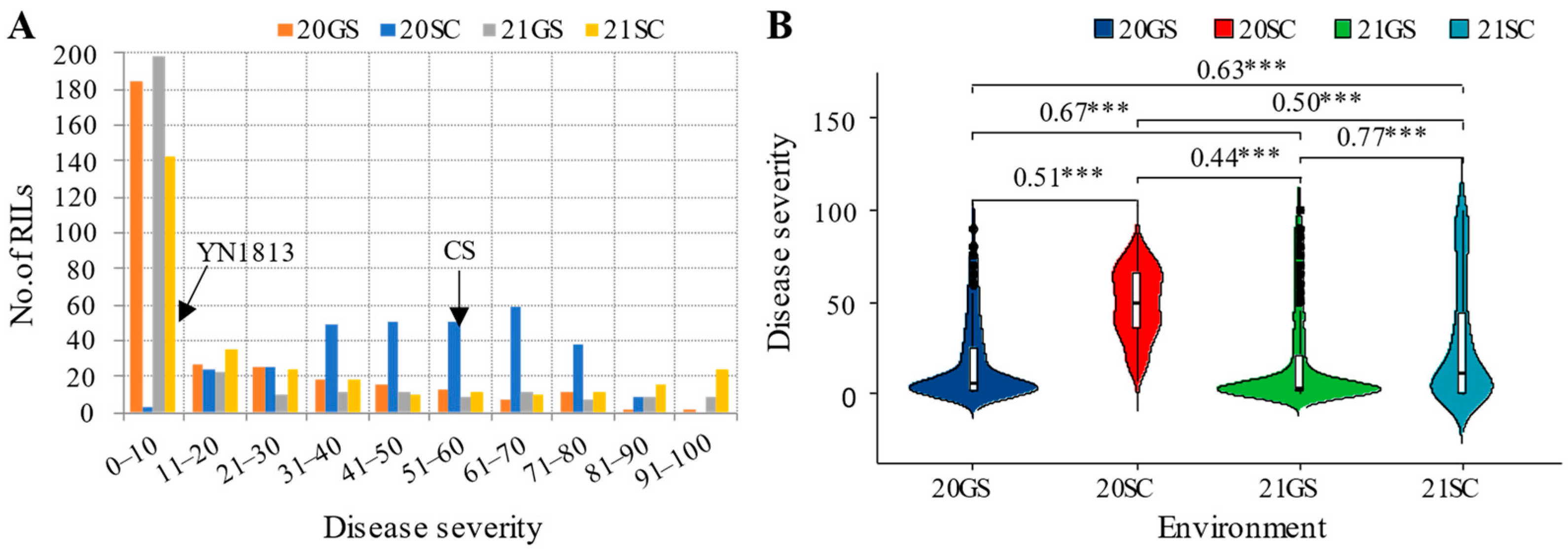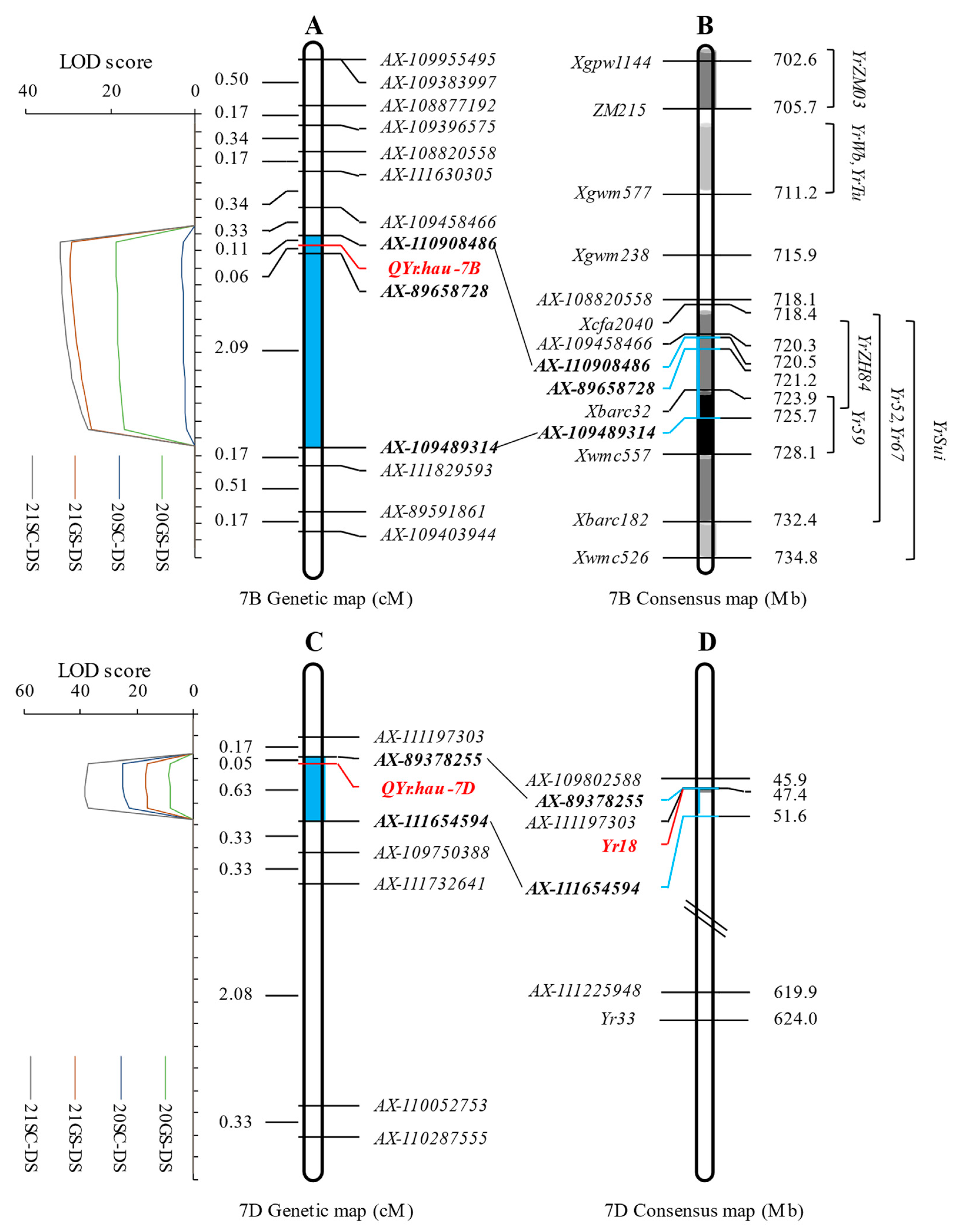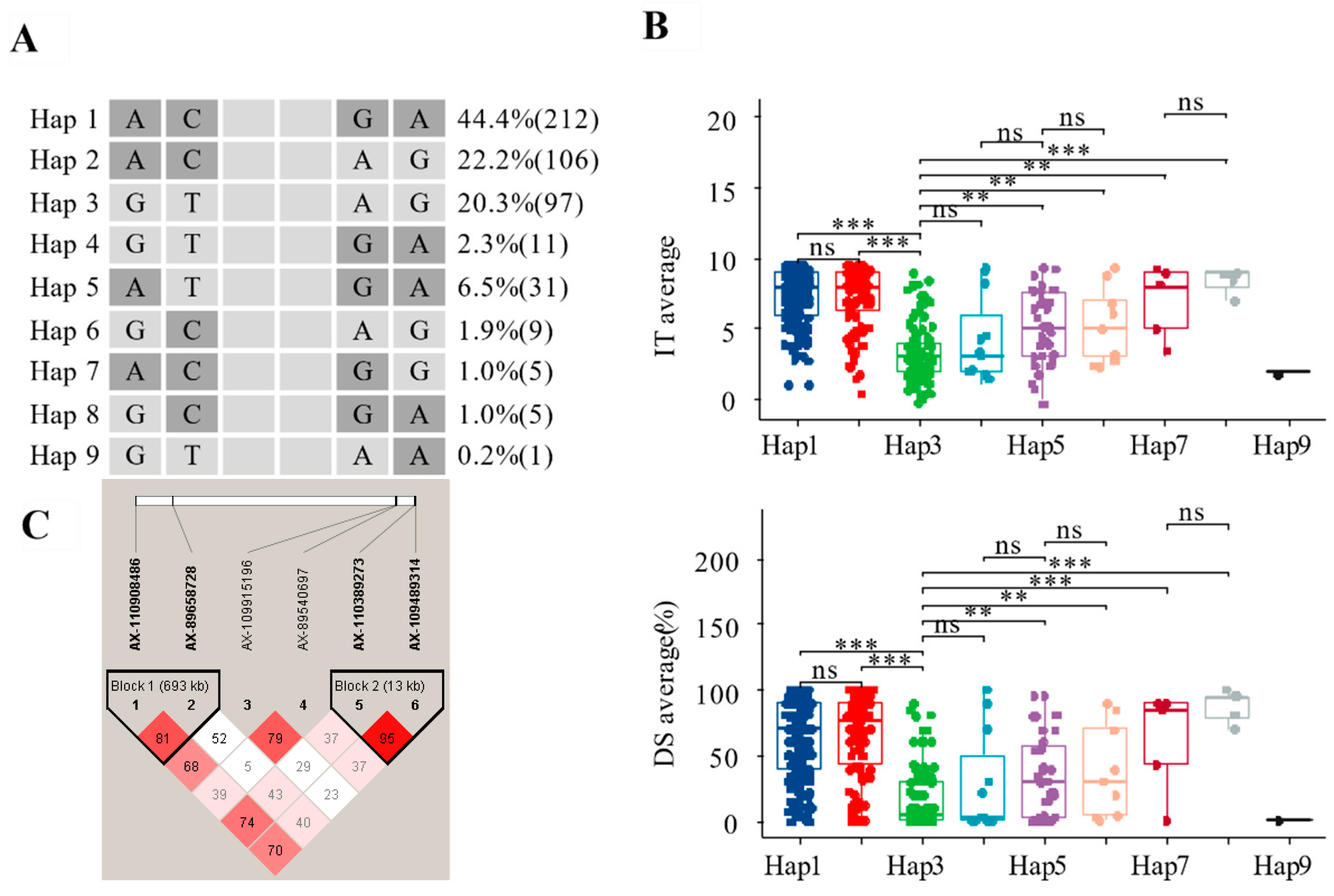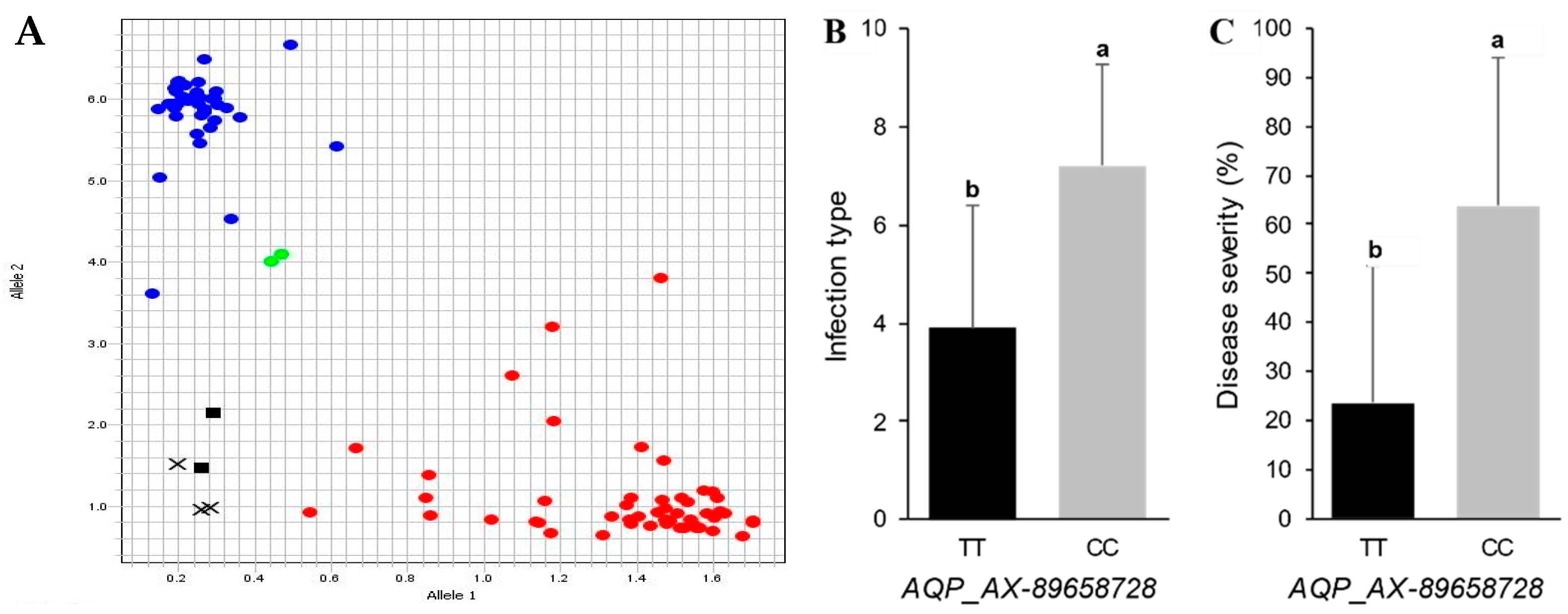Identification and Characterization of Resistance Loci to Stripe Rust in Winter Wheat Breeding Line YN1813
Abstract
:1. Introduction
2. Materials and Methods
2.1. Plant Materials and Pst Races
2.2. Phenotyping of Stripe Rust Resistance
2.3. Phenotypic Statistical Analysis
2.4. Genotyping, Linkage Map Construction, and QTL Analysis
2.5. Haplotype Analysis
2.6. AQP Marker Development and Validation
3. Results
3.1. Inheritance of Stripe Rust Resistance
3.2. Genetic Linkage Maps
3.3. QTL Analysis of Stripe Rust Response
3.4. Effects of QYr.hau-7B and QYr.hau-7D on Stripe Rust Resistance
3.5. Analysis of QYr.hau-7B and QYr.hau-7D Compared with the Known Yr Genes on the Chromosome 7B and 7D
3.6. Development of AQP Markers for QTL Validation and Marker-Assisted Selection
3.7. Distribution of Resistance Accessions and Resistance Genotype (TT) in Different Source Accessions
4. Discussion
4.1. QTL Analysis
4.2. Candidate Region Analysis of QYr.hau-7B
4.3. Comparison of QYr.hau-7B with Previously Reported Genes
5. Conclusions
Supplementary Materials
Author Contributions
Funding
Institutional Review Board Statement
Data Availability Statement
Acknowledgments
Conflicts of Interest
References
- Shewry, P.R.; Hey, S.J. The contribution of wheat to human diet and health. Food Energy Secur. 2015, 4, 178–202. [Google Scholar] [CrossRef] [PubMed]
- Chen, X.M. Epidemiology and control of stripe rust [Puccinia striiformis f. sp. tritici] on wheat. Can. J. Plant Pathol. 2005, 27, 314–337. [Google Scholar] [CrossRef]
- Wellings, C.R. Global status of stripe rust: A review of historical and current threats. Euphytica 2011, 179, 129–141. [Google Scholar] [CrossRef]
- He, Z.H.; Lan, C.X.; Chen, X.M.; Zhou, Y.C.; Zhuang, Q.S.; Xia, X.C. Progress and perspective in research of adult-plant resistance to stripe rust and powdery mildew in wheat. Sci. Agric. Sin. 2011, 44, 2193–2215, (In Chinese with English Abstract). [Google Scholar]
- Chen, X.M. Integration of cultivar resistance and fungicide application for control of wheat stripe rust. Can. J. Plant Pathol. 2014, 36, 311–326. [Google Scholar] [CrossRef]
- McIntosh, R.A.; Dubcovsky, J.; Rogers, W.J.; Xia, X.C.; Raupp, W.J. Catalogue of gene symbols for wheat 2020 Supplement. Ann. Wheat Newslett. 2020, 66, 109–149. Available online: https://wheat.pw.usda.gov/GG3/WGC (accessed on 30 August 2022).
- Klymiuk, V.; Chawla, H.S.; Wiebe, K.; Ens, J.; Fatiukha, A.; Govta, L.; Fahima, T.; Pozniak, C.J. Discovery of stripe rust resistance with incomplete dominance in wild emmer wheat using bulked segregant analysis sequencing. Commun. Biol. 2022, 5, 826. [Google Scholar] [CrossRef] [PubMed]
- Fu, D.L.; Uauy, C.; Distelfeld, A.; Blechl, A.; Epstein, L.; Chen, X.M.; Sela, H.; Fahima, T.; Dubcovsky, J. A Kinase-START gene confers temperature-dependent resistance to wheat stripe rust. Science 2009, 323, 1357–1360. [Google Scholar] [CrossRef]
- Krattinger, S.G.; Lagudah, E.S.; Spielmeyer, W.; Singh, R.P.; Huerta-Espino, J.; Mcfadden, H.; Bossolini, E.; Selter, L.L.; Keller, B. A putative ABC transporter confers durable resistance to multiple fungal pathogens in wheat. Science 2009, 323, 1360–1363. [Google Scholar] [CrossRef]
- Moore, J.W.; Herrera-Foessel, S.; Lan, C.X.; Schnippenkoetter, W.; Ayliffe, M.; Huerta-Espino, J.; Lillemo, M.; Viccars, L.; Milne, R.; Periyannan, S.; et al. A recently evolved hexose transporter variant confers resistance to multiple pathogens in wheat. Nat. Genet. 2015, 47, 1494–1498. [Google Scholar] [CrossRef]
- Liu, W.; Frick, M.; Huel, R.; Nykiforuk, C.L.; Wang, X.M.; Gaudet, D.A.; Eudes, F.; Conner, R.L.; Kuzyk, A.; Chen, Q.; et al. The stripe rust resistance gene Yr10 encodes an evolutionary-conserved and unique CC–NBS–LRR sequence in wheat. Mol. Plant 2014, 7, 1740–1755. [Google Scholar] [CrossRef]
- Klymiuk, V.; Yaniv, E.; Huang, L.; Raats, D.; Fatiukha, A.; Chen, S.S.; Feng, L.H.; Frenkel, Z.; Krugman, T.; Lidzbarsky, G.; et al. Cloning of the wheat Yr15 resistance gene sheds light on the plant tandem kinase-pseudokinase family. Nat. Commun. 2018, 9, 3735. [Google Scholar] [CrossRef]
- Marchal, C.; Zhang, J.P.; Zhang, P.; Fenwick, P.; Steuernagel, B.; Adamski, N.M.; Boyd, L.; Mcintosh, R.; Wulff, B.B.H.; Berry, S.; et al. BED-domain-containing immune receptors confer diverse resistance spectra to yellow rust. Nat. Plants 2018, 4, 662–668. [Google Scholar] [CrossRef]
- Zhang, C.Z.; Huang, L.; Zhang, H.F.; Hao, Q.Q.; Lyu, B.; Wang, M.N.; Epstein, L.; Liu, M.; Kou, C.L.; Qi, J.; et al. An ancestral NB-LRR with duplicated 3′UTRs confers stripe rust resistance in wheat and barley. Nat. Commun. 2019, 10, 178–202. [Google Scholar] [CrossRef]
- Wang, H.; Zou, S.H.; Li, Y.W.; Lin, F.Y.; Tang, D.Z. An ankyrin-repeat and WRKY-domain-containing immune receptor confers stripe rust resistance in wheat. Nat. Commun. 2020, 11, 1353. [Google Scholar] [CrossRef]
- Athiyannan, N.; Abrouk, M.; Boshoff, W.H.P.; Cauet, S.; Rodde, N.; Kudrna, D.; Mohammed, N.; Bettgenhaeuser, J.; Botha, K.S.; Derman, S.S.; et al. Long-read genome sequencing of bread wheat facilitates disease resistance gene cloning. Nat. Genet. 2022, 54, 227–231. [Google Scholar] [CrossRef]
- Clavijo, B.J.; Venturini, L.; Schudoma, C.; Accinelli, G.G.; Kaithakottil, G.; Wright, J.; Borrill, P.; Kettleborough, G.; Heavens, D.; Chapman, H.; et al. An improved assembly and annotation of the allohexaploid wheat genome identifies complete families of agronomic genes and provides genomic evidence for chromosomal translocations. Genome Res. 2017, 27, 885–896. [Google Scholar] [CrossRef]
- Wang, M.; Wang, S.B.; Liang, Z.; Shi, W.M.; Gao, C.X.; Xia, G.M. From genetic stock to genome editing: Gene exploitation in wheat. Trends Biotechnol. 2018, 36, 160–172. [Google Scholar] [CrossRef]
- Allen, A.M.; Barker, G.L.; Wilkinson, P.; Burridge, A.; Winfield, M.; Coghill, J.; Uauy, C.; Griffiths, S.; Jack, P.; Berry, S.; et al. Discovery and development of exome-based, co-dominant single nucleotide polymorphism markers in hexaploid wheat (Triticum aestivum L.). Plant Biotechnol. J. 2013, 11, 279–295. [Google Scholar] [CrossRef]
- Rasheed, A.; Hao, Y.F.; Xia, X.C.; Khan, A.; Xu, Y.B.; Varshney, R.K.; He, Z.H. Crop breeding chips and genotyping platforms: Progress, challenges, and perspectives. Mol. Plant 2017, 10, 1047–1064. [Google Scholar] [CrossRef]
- Zhou, C.E.; Liu, D.; Zhang, X.; Wu, Q.M.; Liu, S.J.; Zeng, Q.D.; Wang, Q.L.; Wang, C.F.; Li, C.L.; Singh, R.P.; et al. Combined linkage and association mapping reveals two major QTL for stripe rust adult plant resistance in Shaanmai 155 and their haplotype variation in common wheat germplasm. Crop J. 2022, 10, 783–792. [Google Scholar] [CrossRef]
- Liu, Z.Y.; Zhang, H.Z.; Bai, B.; Li, J.; Huang, L.; Xu, Z.B.; Chen, Y.X.; Liu, X.; Cao, T.J.; Li, M.M.; et al. Current status and strategies for utilization of stripe rust resistance genes in wheat breeding program of China. Sci. Agric. Sin. 2024, 57, 34–51, (In Chinese with English Abstract). [Google Scholar]
- Nsabiyera, V.; Bariana, H.S.; Qureshi, N.; Wong, D.; Hayden, M.J.; Bansal, U.K. Characterisation and mapping of adult plant stripe rust resistance in wheat accession Aus27284. Theor. Appl. Genet. 2018, 131, 1459–1467. [Google Scholar] [CrossRef]
- Line, R.f.; Qayoum, A. Virulence, Aggressiveness, Evolution, and Distribution of Races of Puccinia striiformis (The Cause of Stripe Rust of Wheat) in North America, 1968–1987; Technical Bulletin Number 1788; United States Department of Agriculture, Agricultural Research Service (USDA-ARS): Pullman, WA, USA, 1992.
- Bariana, H.S.; McIntosh, R.A. Cytogenetic studies in wheat. XV. Location of rust resistance genes in VPM1 and their genetic linkage with other disease resistance genes in chromosome 2A. Genome 1993, 36, 476–482. [Google Scholar] [CrossRef]
- Meng, L.; Li, H.H.; Zhang, L.Y.; Wang, J.K. QTL IciMapping: Integrated software for genetic linkage map construction and quantitative trait locus mapping in biparental populations. Crop J. 2015, 3, 269–283. [Google Scholar] [CrossRef]
- Bansal, U.; Bariana, H.; Wong, D.; Randhawa, M.; Wicker, T.; Hayden, M.; Keller, B. Molecular mapping of an adult plant stem rust resistance gene Sr56 in winter wheat cultivar Arina. Theor. Appl. Genet. 2014, 127, 1441–1448. [Google Scholar] [CrossRef]
- Liu, R.H.; Meng, J.L. MapDraw: A Microsoft excel macro for drawing genetic linkage maps based on given genetic linkage data. Hereditas 2003, 25, 317–321, (In Chinese with English Abstract). [Google Scholar]
- Barrett, J.C.; Fry, B.; Maller, J.; Daly, M.J. Haploview: Analysis and visualization of LD and haplotype maps. Bioinformatics 2005, 21, 263–265. [Google Scholar] [CrossRef]
- Ramirez-Gonzalez, R.H.; Uauy, C.; Caccamo, M. PolyMarker: A fast polyploid primer design pipeline. Bioinformatics 2015, 31, 2038–2039. [Google Scholar] [CrossRef]
- Feng, J.Y.; Wang, M.N.; See, D.R.; Chao, S.M.; Zheng, Y.L.; Chen, X.M. Characterization of novel gene Yr79 and four additional quantitative trait loci for all-stage and high-temperature adult-plant resistance to stripe rust in spring wheat PI 182103. Phytopathology 2018, 108, 737–747. [Google Scholar] [CrossRef]
- Ren, Y.; Li, S.R.; Xia, X.C.; Zhou, Q.; He, Y.J.; Wei, Y.M.; Zheng, Y.L.; He, Z.H. Molecular mapping of a recessive stripe rust resistance gene YrMY37 in Chinese wheat cultivar Mianmai 37. Mol. Breed. 2015, 35, 97. [Google Scholar] [CrossRef]
- Li, Y.H.; Lin, R.M.; Hu, J.H.; Shi, X.H.; Qiu, D.; Wu, P.P.; Goitom, G.H.; Wang, S.Q.; Zhang, H.J.; Yang, L.; et al. Mapping of wheat stripe rust resistance gene Yr041133 by BSR-seq analysis. Crop J. 2022, 10, 447–455. [Google Scholar] [CrossRef]
- Lin, F.; Chen, X.M. Genetics and molecular mapping of genes for race-specific all-stage resistance and non-race-specific high-temperature adult-plant resistance to stripe rust in spring wheat cultivar Alpowa. Theor. Appl. Genet. 2007, 114, 1277–1287. [Google Scholar] [CrossRef]
- Zhang, H.Z.; Xie, J.Z.; Chen, Y.X.; Liu, X.; Wang, Y.; Yan, S.H.; Yang, Z.S.; Zhao, H.; Wang, X.C.; Jia, L.H.; et al. Mapping stripe rust resistance gene YrZM103 in wheat cultivar Zhengmai 103 by BSR-seq. Acta Agron. Sin. 2017, 43, 1643–1649. [Google Scholar] [CrossRef]
- Dawit, W.; Flath, K.; Weber, W.E.; Schumann, E.; Röder, M.S.; Chen, X.M. Postulation and mapping of seedling stripe rust resistance genes in Ethiopian bread wheat cultivars. J. Plant Pathol. 2012, 94, 403–409. [Google Scholar]
- Ren, R.S.; Wang, M.N.; Chen, X.M.; Zhang, Z.J. Characterization and molecular mapping of Yr52 for high-temperature adult-plant resistance to stripe rust in spring wheat germplasm PI 183527. Theor. Appl. Genet. 2012, 125, 847–857. [Google Scholar] [CrossRef] [PubMed]
- Zhou, X.L.; Wang, M.N.; Chen, X.M.; Lu, Y.; Kang, Z.S.; Jing, J.X. Identification of Yr59 conferring high-temperature adult-plant resistance to stripe rust in wheat germplasm PI 178759. Theor. Appl. Genet. 2014, 127, 935–945. [Google Scholar] [CrossRef]
- Li, Y.; Niu, Y.C.; Chen, X.M. Mapping a stripe rust resistance gene YrC591 in wheat variety C591 with SSR and AFLP markers. Theor. Appl. Genet. 2009, 118, 339–346. [Google Scholar] [CrossRef]
- Xu, H.X.; Zhang, J.; Zhang, P.; Qie, Y.M.; Niu, Y.C.; Li, H.J.; Ma, P.T.; Xu, Y.F.; An, D.G. Development and validation of molecular markers closely linked to the wheat stripe rust resistance gene Yrc591 for marker-assisted selection. Euphytica 2014, 198, 317–323. [Google Scholar] [CrossRef]
- Li, Z.F.; Zheng, T.C.; He, Z.H.; Li, G.Q.; Xu, S.C.; Li, X.P.; Yang, G.Y.; Singh, R.P.; Xia, X.C. Molecular tagging of stripe rust resistance gene YrZH84 in Chinese wheat line Zhou 8425b. Theor. Appl. Genet. 2006, 112, 1098–1103. [Google Scholar] [CrossRef]
- Lan, C.X.; Zhang, Y.L.; Herrera-foessel, S.A.; Basnet, B.R.; Huerta-espino, J.; Lagudah, E.S.; Singh, R.P. Identification and characterization of pleiotropic and co-located resistance loci to leaf rust and stripe rust in bread wheat cultivar Sujata. Theor. Appl. Genet. 2015, 128, 549–561. [Google Scholar] [CrossRef] [PubMed]
- Liu, S.J.; Wang, X.T.; Zhang, Y.Y.; Jin, Y.G.; Xia, Z.H.; Xiang, M.J.; Huang, S.; Qiao, L.Y.; Zheng, W.J.; Zeng, Q.D.; et al. Enhanced stripe rust resistance obtained by combining Yr30 with a widely dispersed, consistent QTL on chromosome arm 4BL. Theor. Appl. Genet. 2022, 135, 351–365. [Google Scholar] [CrossRef]
- Liu, B.; Liu, T.G.; Zhang, Z.Y.; Jia, Q.Z.; Wang, B.T.; Gao, L.; Peng, Y.L.; Jin, S.L.; Chen, W.Q. Discovery and pathogenicity of CYR34, a new race of Puccinia striiformis f. sp. tritici in China. Acta Phytopathol. Sin. 2017, 47, 681–687, (In Chinese with English Abstract). [Google Scholar]
- Wu, J.H.; Wang, Q.L.; Chen, X.M.; Wang, M.J.; Mu, J.M.; Lv, X.N.; Huang, L.L.; Han, D.J.; Kang, Z.S. Stripe rust resistance in wheat breeding lines developed for central Shaanxi, an overwintering region for Puccinia striiformis f. sp. tritici in China. Can. J. Plant Pathol. 2016, 38, 317–324. [Google Scholar] [CrossRef]
- Deng, M.; Long, L.; Cheng, Y.K.; Yao, F.J.; Guan, F.N.; Wang, Y.Q.; Li, H.; Pu, Z.E.; Li, W.; Jiang, Q.T.; et al. Mapping a stable adult-plant stripe rust resistance QTL on chromosome 6AL in Chinese wheat landrace Yibinzhuermai. Crop J. 2022, 10, 1111–1119. [Google Scholar] [CrossRef]
- Mu, J.M.; Huang, S.; Liu, S.J.; Zeng, Q.D.; Dai, M.F.; Wang, Q.L.; Wu, J.H.; Yu, S.Z.; Kang, Z.S.; Han, D.E. Genetic architecture of wheat stripe rust resistance revealed by combining QTL mapping using SNP-based genetic maps and bulked segregant analysis. Theor. Appl. Genet. 2019, 132, 443–455. [Google Scholar] [CrossRef] [PubMed]
- Yin, G.H.; Wang, J.W.; Wen, W.E.; He, Z.H.; Li, Z.F.; Wang, H.; Xia, X.C. Mapping of wheat stripe rust resistance gene YrZH84 with RGAP markers and its application. Acta Agron. Sin. 2009, 35, 1274–1281, (In Chinese with English Abstract). [Google Scholar] [CrossRef]






| Environments | Parents | RIL (n = 306) | H2 | |||
|---|---|---|---|---|---|---|
| YN1813 | CS | Min | Max | Mean | ||
| IT | ||||||
| 20GS | 0 | 9 | 0 | 9 | 4.4 | |
| 21GS | 3 | 7 | 0 | 9 | 3.6 | |
| 21SC | 3 | 7 | 0 | 9 | 4.2 | |
| DS (%) | ||||||
| 20GS | 1 | 59 | 1 | 90 | 16.0 | 0.82 |
| 20SC | 36 | 65 | 7 | 87 | 48.5 | 0.82 |
| 21GS | 2 | 58 | 0 | 100 | 17.0 | 0.87 |
| 21SC | 1 | 41 | 0 | 100 | 26.8 | 0.94 |
| Average | 10.1 | 55.5 | 1.8 | 94.2 | 27.1 | 0.86 |
| QTL, Environment | Genetic Position a (cM) | Flanking Marker | Genetic Interval (cM) | Physical Interval b (Mb) | LOD | PVE (%) | Add |
|---|---|---|---|---|---|---|---|
| QYr.hau-7B | |||||||
| 20GS-DS | 444.21 | AX-110908486–AX-89658728 | 444.22–444.05 | 720.5–721.2 | 18.9 | 0.9 | −9.6 |
| 20SC-DS | 444.01 | AX-89658728–AX-109489314 | 444.05–441.96 | 721.2–725.7 | 3.2 | 2.2 | −3.1 |
| 21GS-DS | 444.01 | AX-89658728–AX-109489314 | 444.05–441.96 | 721.2–725.7 | 29.8 | 3.7 | −13.9 |
| 21SC-DS | 444.21 | AX-110908486–AX-89658728 | 444.22–444.05 | 720.5–721.2 | 31.8 | 16.9 | −15.4 |
| QYr.hau-7D | |||||||
| 20GS-DS | 294.60 | AX-89378255–AX-111654594 | 294.65–293.97 | 47.4–51.6 | 8.4 | 0.4 | 6.3 |
| 20SC-DS | 294.60 | AX-89378255–AX-111654594 | 294.65–293.97 | 47.4–51.6 | 25.3 | 20.4 | 9.8 |
| 21GS-DS | 294.60 | AX-89378255–AX-111654594 | 294.65–293.97 | 47.4–51.6 | 16.9 | 1.9 | 10.1 |
| 21SC-DS | 294.40 | AX-89378255–AX-111654594 | 294.65–293.97 | 47.4–51.6 | 38.2 | 21.4 | 17.6 |
| Country | Origin | No. | IT Mean | DS Mean | R No. (%) | R/TT No. (%) |
|---|---|---|---|---|---|---|
| China | Henan | 339 | 5.9 | 48.3 | 160 (47.2) | 104 (65) |
| China | Sichuan | 50 | 4.6 | 26.3 | 40 (80.0) | 7 (17.5) |
| China | Shandong | 48 | 8.2 | 78.5 | 5 (10.4) | 1 (20.0) |
| China | Hebei | 44 | 8.2 | 81.5 | 5 (11.4) | 2 (40.0) |
| China | Jiangsu | 42 | 8.3 | 84.1 | 5 (11.9) | 1 (20.0) |
| China | Anhui | 41 | 8.2 | 82.1 | 2 (4.9) | 1 (50.0) |
| China | Beijing | 25 | 5.9 | 47.9 | 11 (44.0) | 7 (63.6) |
| China | Shanxi | 21 | 5.9 | 44.9 | 15 (71.4) | 0 (0.0) |
| China | other | 19 | 5.9 | 47.7 | 10 (52.6) | 5 (50.0) |
| China | Guizhou | 6 | 6.3 | 45.5 | 4 (66.7) | 0 (0.0) |
| China | Yunnan | 4 | 2.8 | 8.8 | 4 (100.0) | 0 (0.0) |
| China | Ningxia | 3 | 8.7 | 86.7 | 3 (100.0) | 0 (0.0) |
| China | Chongqing | 2 | 5.0 | 26.5 | 2 (100.0) | 0 (0.0) |
| China | Hubei | 2 | 5.0 | 50.0 | 1 (50.0) | 0 (0.0) |
| China | Tianjin | 2 | 7.5 | 77.5 | 2 (100.0) | 0 (0.0) |
| China | Shan’xi | 1 | 8.0 | 80.0 | 0 (0.0) | 0 (-) |
| China | Xinjiang | 1 | 8.0 | 70.0 | 1 (100.0) | 0 (0.0) |
| CIMMYT | 46 | 4.3 | 27.5 | 33 (71.7) | 24 (72.7) | |
| Australia | 7 | 6.4 | 55.7 | 2 (28.6) | 1 (50.0) | |
| Europe | 3 | 3.3 | 12.0 | 3 (100.0) | 2 (66.7) | |
| France | 3 | 6.3 | 50.3 | 1 (33.3) | 1 (100.0) | |
| America | 1 | 4.0 | 40.0 | 1 (100.0) | 1 (100.0) | |
| Holland | 1 | 3.0 | 1.0 | 1 (100.0) | 0 (0.0) | |
| Mexico | 1 | 4.0 | 40.0 | 1 (100.0) | 1 (100.0) |
Disclaimer/Publisher’s Note: The statements, opinions and data contained in all publications are solely those of the individual author(s) and contributor(s) and not of MDPI and/or the editor(s). MDPI and/or the editor(s) disclaim responsibility for any injury to people or property resulting from any ideas, methods, instructions or products referred to in the content. |
© 2024 by the authors. Licensee MDPI, Basel, Switzerland. This article is an open access article distributed under the terms and conditions of the Creative Commons Attribution (CC BY) license (https://creativecommons.org/licenses/by/4.0/).
Share and Cite
Tang, J.; Gao, Y.; Li, Y.; Bai, B.; Wu, L.; Ren, Y.; Geng, H.; Yin, G. Identification and Characterization of Resistance Loci to Stripe Rust in Winter Wheat Breeding Line YN1813. Agriculture 2024, 14, 1044. https://doi.org/10.3390/agriculture14071044
Tang J, Gao Y, Li Y, Bai B, Wu L, Ren Y, Geng H, Yin G. Identification and Characterization of Resistance Loci to Stripe Rust in Winter Wheat Breeding Line YN1813. Agriculture. 2024; 14(7):1044. https://doi.org/10.3390/agriculture14071044
Chicago/Turabian StyleTang, Jianwei, Yan Gao, Yujia Li, Bin Bai, Ling Wu, Yi Ren, Hongwei Geng, and Guihong Yin. 2024. "Identification and Characterization of Resistance Loci to Stripe Rust in Winter Wheat Breeding Line YN1813" Agriculture 14, no. 7: 1044. https://doi.org/10.3390/agriculture14071044
APA StyleTang, J., Gao, Y., Li, Y., Bai, B., Wu, L., Ren, Y., Geng, H., & Yin, G. (2024). Identification and Characterization of Resistance Loci to Stripe Rust in Winter Wheat Breeding Line YN1813. Agriculture, 14(7), 1044. https://doi.org/10.3390/agriculture14071044






